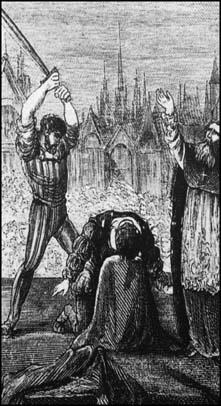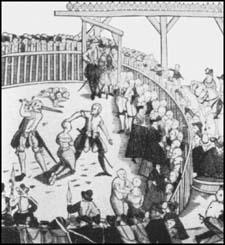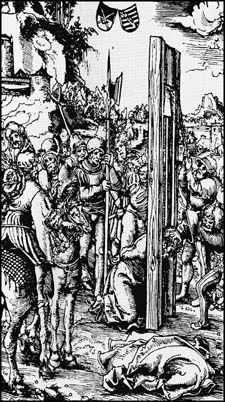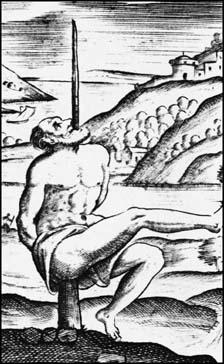The Big Book of Pain: Torture & Punishment Through History (36 page)
Read The Big Book of Pain: Torture & Punishment Through History Online
Authors: Daniel Diehl


Beheading.
Adopted by the French in 1785, the towering crossbeams and swiftly descending blade became a national fetish symbol throughout the period of the French Revolution and the ensuing Reign of Terror. The last guillotine disappeared in 1946 when France closed down its notorious prison colony known as ‘Devil’s Island’.

Headsman’s axe and block.
BLOOD EAGLE
The blood eagle was a uniquely decorative form of butchery supposedly practiced by the Vikings as a means of demonstrating to their victims that they meant business. The victim in question, usually a chieftain or other local authority figure, was stripped to the waist and bent forward before his ribs were hacked free of his backbone. The executioner would then pull out the victim’s lungs, careful not to rip them loose. The results, at least until the victim died a few excruciating hours later, gave the appearance of a pair of flapping, bloody wings – hence the name of the torture.

Thirty-four pirates beheaded in twenty-seven minutes.
DEATH BY ONE THOUSAND CUTS
See
Ling Che
, below, in this section.
FLAYING
The idea of tearing the skin from a living human being may be as old as cruelty itself, but it first occurs in the records of medieval Europe around 1100 AD. How late this grim practice was still imposed is unknown, but records show that as late as 1366 the Count de Rouci was skinned alive for having betrayed Lyon, France to the English. Generally, the victim was tied, upside-down, to a square frame, in a spread-eagle position. The executioner would then ring his ankles with a sharp knife and make an incision down the inner surface of each leg, again ringing the genitals, and continue the slit down the victim’s stomach and chest. Beginning at the ankles, the skin was then stripped away from the victim much like a hunter skins an animal after shooting it. If the pain of having one’s skin ripped from the body, and exposing the sensitive inner flesh and muscle to the air, were not horrific enough, by the time the peeling process reached the stomach the intestines were likely to tumble out and fall over the victim’s face. Once nearly devoid of skin, the victim would be left exposed until they died of shock and blood loss.

Executioner’s beheading sword.
HANGING, DRAWING AND QUARTERING
Hanging, drawing and quartering, that uniquely medieval sounding torture, was probably devised in 1241 by England’s King Henry III. The best description of the process would seem to be in the words read out when a judge imposed this particularly gruesome execution on someone who had been convicted of treason. He announced to the court that the condemned was:
to be taken from the prison and laid upon a sledge or hurdle, and drawn to the gallows or place of execution, and then hanged by the neck until he be half-dead, and then cut down; and his entrails [are] to be cut from his body and burned by the executioner; then his head is to be struck off, his body divided into quarters and afterwards his head and quarters to be set up in some open places as directed.

Early guillotine.
Not mentioned in the official wording are several details worth noting. After being hanged the victim was awakened as much as possible by having water thrown onto his face; otherwise he might miss what was to come. Next, before he was disembowelled, his private parts were cut off and tossed into the waiting fire – this was to show that traitors would not be allowed to reproduce (even if he thought he would have time or opportunity prior to his decapitation). The disembowelling (technically the ‘drawing’ part of the sentence as the bowels were said to be ‘drawn out from the body’) if done by an experienced executioner, could be accomplished without the victim losing consciousness. Then, while the poor wretch was still screaming, the executioner would reach inside the trunk of his body, rip out his heart, hold it up before the cheering, jeering crowd and cry out: ‘Behold, the heart of a traitor!’ The records indicate any number of hanging, drawing and quarterings where the victim remained conscious, screaming and praying right up until the point where either their heart was pulled out or their head was struck off. The various cuts of carcass mentioned in the official sentence – the head and four quarters of the body – were then parboiled with bay leaves and cumin seed as preservatives and given a liberal coating of tar before being affixed on a pike and used to decorate town gates and bridges throughout the kingdom. Records show that these well-preserved cuts of corpse could last for decades before the elements and the crows reduced them to mere bones. The last recorded hanging, drawing and quartering in England took place on 20 September 1586 when seven of fourteen men convicted of plotting the murder of Queen Elizabeth were dispatched in this manner.

Heretic’s fork.
HERETIC’S FORK
This creatively painful device was designed to make the life of an accused heretic even more miserable than it already was. The instrument itself looked like a leather dog collar with the business end of two table forks attached to it at right angles. When the collar was latched around the victim’s neck, the forks were situated so that one jabbed him beneath the chin and the other rested in the hollow at the bottom of the throat where it joins the collar bone. If the prisoner attempted to lower or even move their head, the tines of the fork bit deep into the flesh, impaling the tongue and digging into the throat. The tines were not long enough and not situated at such a position that they would kill, but were undoubtedly amazingly painful.

Heretic’s fork.

Impaling.
